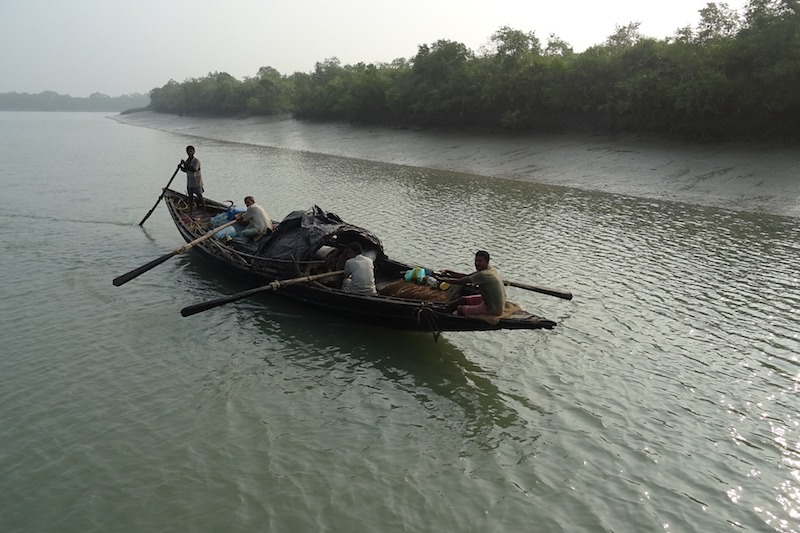 Sundarbans
Sundarbans Every year tropical cyclones throw up new challenges to thousands of rural folks living in one of the richest but most fragile ecosystems on the planet, Sunderbans. Amid the destruction of the swamps by private fisheries, environmentalists say this is high time for the state administration to introduce a long-term participatory management in the deltaic belts of West Bengal. Soudhriti Bhabani reports from ground zero
For nearly five million inhabitants in the Sunderbans region, life has never been an easy affair as it revolves around battling high tides every day and cyclones with almost periodic regularity.
Formed by 56 riverine islands, the alluvial archipelago has been ravaged by four back to back tropical cyclones - Fani and Bulbul in May and November 2019 respectively, Amphan in May 2020 and Yaas in May 2021. And before all these, it was Aila that battered the UNESCO World Heritage Site in 2009.
Every time life came to a standstill for people living in the ecologically fragile Sunderbans.
.jpg)
Every time, the region either suffered severe damage owing to heavy cyclonic spells and breached embankments leading to ingress of salt water or by some man-made crisis - something that the policy makers were not really prepared for.
According to green watchdogs, the region is currently facing its worst challenge with hundreds of acres of mangrove swamps being destroyed for setting up private fisheries. Such activities are rampant in areas like Satjelia, Mollahkhali, Basanti, Kultoli, Sagar Island and Patharpratima where thousands of acres of mangrove land have been wiped off by private players in order to set up fishery units.
“If this goes on it would be really difficult to save Sundarbans – a home to the famous Royal Bengal Tiger and Gangetic dolphin. The administration needs to look into it immediately. It must involve the locals and sensitise them about the aftermath of such environmentally-atrocious act,” said veteran environmentalist and West Bengal's ex-chief conservator of forest Pranabesh Sanyal.
Even this year the region had a narrow escape from severe cyclonic storm ‘ASANI’, which was centering over West Central Bay of Bengal before it moved steadily towards northwest Bay of Bengal to inch closer to coastal Andhra Pradesh.
Sanyal said that a few attempts were foiled in Satjelia and Mollahkhali recently. He pointed out that such illegal activities started taking place in Sunderbans in the last four-five months. The offenders not only destroyed large stretches of mangrove land but also erected small construction sites near Piyali Island at Patharpratima.
Sources in Sunderbans said that some NGOs are carrying out ground-level sensitisation drives among villagers so that they realise the impending danger and put up a strong resistance against such ecologically damaging activities that are often taking place with political patronage.
It is true that in order to minimise damage caused by cyclonic storms, the district administration is putting important measures in place. The local administration has started conducting meetings, keeping in mind how to lower the damage. But the flip side is that the area itself is on the frontline of natural disasters.
Anil Mistry, a 55-year-old poacher-turned conservationist, said that people of Sunderbans have become more dependent on the state administration these days. He said that earlier villagers in the deltaic belts used to take active part in natural embankment protection and mangrove plantation.
“But the drive has gone for a toss in the last 10 years in West Bengal’s Sunderbans,” said Mistry who is also the principal field officer for Wildlife Protection Society of India in the Sundarbans. According to experts, the solution to the perennial problem lies in long-term planning, adopting strategies that will minimize the impact of climate change and other external factors.
Flooding of low-lying deltas, the retreat of shorelines, salinization and acidification of soils, and changes in the water table have posed serious concerns for the well-being of local populations as well as the diverse species thriving in the Sunderbans delta.

Located in Kolkata’s neighbouring North 24-Parganas and South 24-Parganas district, the Sundarbans has a vast area covering 4,262 sq km, including a mangrove cover of 2,125 sq km, in India alone. A larger portion lies in Bangladesh. The vast tract of forest and saltwater swamps is located at the lower part of the Ganges delta, extending 260-km along the Bay of Bengal from the Hooghly river estuary in India to the Meghna river estuary in Bangladesh.
To remember, there are over 1000 such World Heritage sites across 167 countries that are chosen, protected and maintained by UNESCO and the conservation programme is ratified by the 194 countries, making it one of the widest recognised international agreements.
The Sundarbans is one such heritage site which is struggling to survive and stay resilient against serious challenges to its existence.
Images: Pixabay and the author
(The writer is a journalist, independent filmmaker and podcaster. He can be reached on soudhriti@gmail.com)
Support Our Journalism
We cannot do without you.. your contribution supports unbiased journalism
IBNS is not driven by any ism- not wokeism, not racism, not skewed secularism, not hyper right-wing or left liberal ideals, nor by any hardline religious beliefs or hyper nationalism. We want to serve you good old objective news, as they are. We do not judge or preach. We let people decide for themselves. We only try to present factual and well-sourced news.







